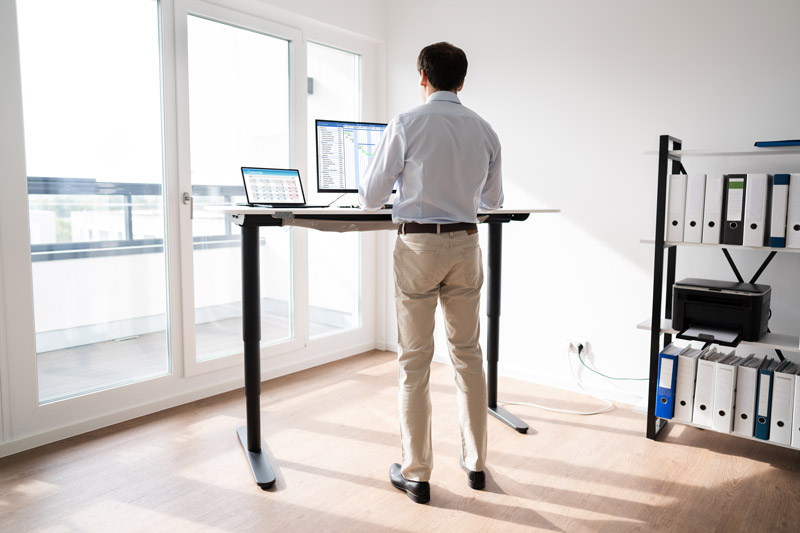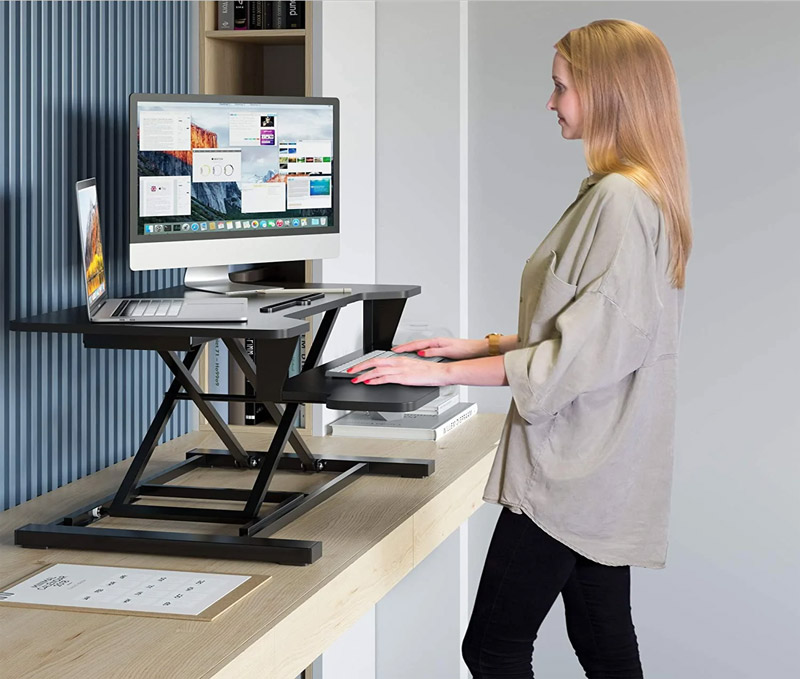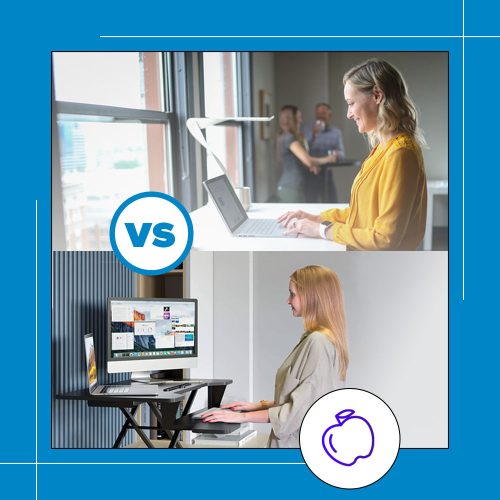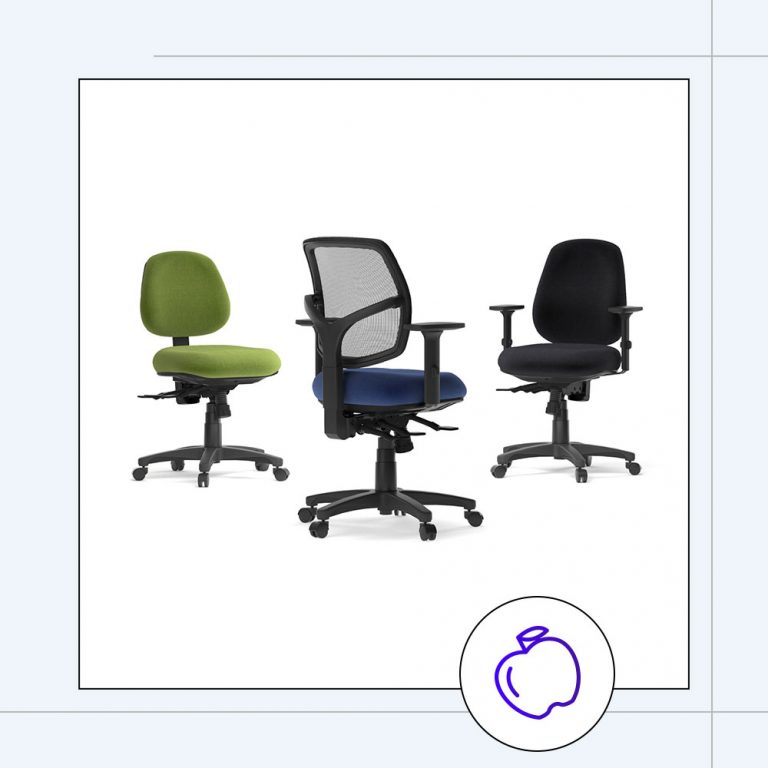When it comes to standing desks, there are two main types: the standing desk (the adjustable type) and the standing desk converter. Both have pros and cons, and it can be hard to decide which is the best option. This article will compare the two options and help you decide the best choice for your needs. Let’s do it – let’s pit the two against each other in the ultimate battle: Standing Desks vs Standing Desk Converters.
What Is a Standing Desk?
The height-adjustable standing desk has become a popular solution for those who want to avoid the health risks associated with sitting for long periods. Evidence suggests that too much sitting can lead to a host of problems, including obesity, heart disease, and diabetes. The standing desk allows you to change positions throughout the day, giving your body a chance to move and stay active. In addition, having an adjustable workspace makes it easy to customize your setup to maximize comfort and efficiency. The standing desk is worth considering whether you’re looking to improve your health or want a more flexible workstation.

What is a standing desk converter?
A desk converter is an adjustable workspace that allows you to switch between sitting and working in a standing position. It is a raised surface, generally composed of a durable material such as wood or metal. The top sometimes includes ergonomic features like soft anti-fatigue mats, a keyboard platform, and a monitor arm. Desk converters are popular among people who want to improve their health by avoiding the health risks associated with sitting for long periods.

Is standing at your desk while you work actually beneficial?
There are many benefits to working while standing up on a health and productivity level. Some of these benefits include reducing the risk of heart disease, improving your mood, increasing your energy, and helping you to focus. Additionally, working while standing up can help you lose or maintain a healthy weight.
When you are standing, your body is constantly active and moving. This helps to keep your metabolism going and prevents the blood from pooling in your lower extremities. When you sit, on the other hand, your muscles are relaxed, and you are not burning as many calories.
Standing also helps to improve your posture. There are numerous health benefits of standing desks. When you sit all day long, your muscles get used to being in that position and start to weaken. This can lead to back and neck pain, as well as poor circulation. Regularly Standing up helps to reverse these negative effects and keeps your body strong and healthy.
Standing Desk Converter pros and cons
Standing desk converters are a great way to get many of the benefits of a standing desk without having to invest in a new desk or office chair. They are affordable, easy to use, and portable. But they do come with some drawbacks.
Pros:
- Standing desk converters are affordable; many cost under $200.
- They are easy to use; you simply place them on top of your current desk and adjust the height to fit your needs. You can keep your existing desk, that’s a big bonus.
- They are portable; you can take them with you when you travel or move offices.
- You get many of the benefits of standing desks, at a fraction of the cost.
Cons:
- They can be cumbersome and take up a lot of your existing desk space.
- Standing desk converters can be flimsy and unstable – Not as stable as a complete standing desk.
- They may not be suitable for everyone, as they can cause back and neck pain if not used correctly.
- Some standing desk converters do not have a lot of adjustability, which can make them uncomfortable to use.
Standing Desks pros and cons
A standing desk, or stand-up desk, is an adjustable desk that allows you to easily switch between sitting to standing and working in a standing position. Unlike a standing desk converter, your whole desk space is height adjustable. There is no need for a keyboard tray, and they are arguably the best choice for a complete ergonomic office.
Pros:
- They are easy to use; you can typically adjust them at the touch of a button if you have an electric one.
- They help improve your posture and circulation.
- They are (if you have a high-quality standing desk) very robust and stable.
- Your desk layout doesn’t need to be changed when you switch between a seated or standing position. Your work surface, monitor, keyboard and mouse can all stay the same.
While standing desks do have some benefits, they also have some drawbacks. One of the main cons is that they need to be used correctly in order to be of benefit. You should alternate between sitting and standing at regular intervals to prevent pain. If you are not used to standing for long periods of time, you may experience back and neck pain. Additionally, they often cost more than regular desks or standing desk converters.
Cons:
- They can be uncomfortable to use for long periods of time – if not switched between sitting and standing throughout the day.
- They can be quite expensive compared to regular desks.
So, which one should you choose?
When it comes to choosing the right option for you, there are many factors to consider.
Based on your budget
When it comes to standing desks, there are two main types: those that are based on a converter and those that are standalone. Standing desk converters are cheaper, but they can be less comfortable and more prone to wobbling. A standing desk converter desk is the way to go if you have a tight budget. However, if you can afford it, we would recommend opting for a standalone sit-stand desk instead. This will be more comfortable and stable and will last longer than a converter desk.
Based on ergonomics
Aside from budget, it’s important to consider ergonomics when choosing a standing desk type. Make sure the height is adjustable so you can find the most comfortable position for your body. Also, look for features like anti-fatigue mats and keyboard platforms to help improve posture and alleviate strain on your wrists and arms.
Ultimately, it’s all about finding what works best for you and your needs. Experiment with different options until you find the perfect fit for a healthier, more productive workspace.
Either a standing desk or a desk converter will improve ergonomics however, sit-stand desks arguably provide the cleanest, easiest and sturdiest path toward ideal ergonomics.
Based on your storage needs
If you need a lot of storage space, a standing desk converter may be a better option than a traditional standing desk if you don’t want to invest in new under-desk storage. You can purchase mobile pedestals in numerous configurations if you require storage below a standing desk. Converters tend to be smaller in size, making them ideal for small spaces.
Based on health benefits
Essentially, the benefits come from standing from time to time instead of sitting all day. This can help improve posture, decrease back pain, and increase energy and circulation. Being just a little bit more active by standing at work can also aid in weight loss and have the added benefits of reducing the risk of health conditions such as heart disease and diabetes. However, it’s important to note that standing all day can also lead to strain and discomfort in the feet, legs, and back. That’s why it’s important to find a stand-up desk with adjustable heights so you can switch between sitting and standing throughout the day.
In addition to the physical benefits, using a stand-up desk can also do wonders for your mental health and productivity. Standing while working can focus, leading to improved concentration and performance – who wouldn’t want that.
Overall, incorporating a stand-up desk or standing desk converter into your workspace can have numerous benefits for your health and well-being. So give it a shot – your body will thank you!
Based on your office space
You might already have a desk that you love. In that case, consider investing in a standing desk converter. This option allows you to transform your existing workspace into a standing desk without having to purchase and assemble a whole new one.
If you have the flexibility to choose your own desk, take some time to research and test out options before making a decision. Consider the size of your office space and the various features offered by different desks. And don’t forget about aesthetics – make sure it fits in with the rest of your decor!
What is the best standing desk?
Full disclosure, we believe our BFX sit-stand desks are the best in the market. However, ultimately the best standing desk is the one that meets your individual needs and preferences. It should fit well in your workspace, offer features that support ergonomics and comfort, and be durable enough to withstand daily use. Do your research and test out options before making a final decision – your future self will thank you!
What is the best standing converter?
Similar to the standing desk, the best standing converter is the one that meets your individual needs and preferences. Consider factors like weight limit, stability, and adjustability. And don’t forget to make sure it fits well with your current workspace setup! Again, do your research and test out options before making a final decision.
Final Thoughts
Regardless of what type of standing desk you go with, remember to switch between sitting and standing throughout the day. Alternate positions every 30-60 minutes to give your body a break and prevent fatigue or discomfort. And as always, listen to your body’s signals and adjust accordingly.
Using a standing desk can offer numerous health benefits, including improved posture, increased energy levels, and reduced risk of chronic diseases. So why not give it a try and see how it works for you? Your body will thank you. Happy standing!













